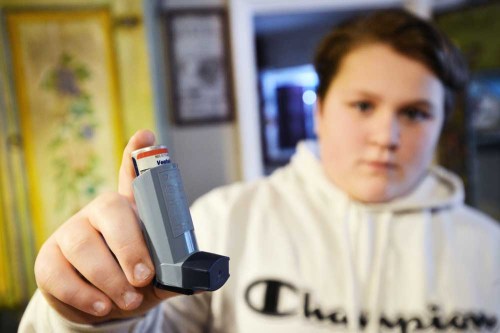Measure 101 and the insurance net
Published 7:41 am Tuesday, January 2, 2018

- Staff photo by E.J. Harris Anderson Dokka, 13, holds up his asthma inhaler that would cost $70 without coverage from Medicaid expantion due to the Affordable Care Act.
Jennifer Dokka doesn’t want to contemplate what might happen if Measure 101 fails.
The single mother supports two sons by cleaning houses, but there isn’t a lot left over for medical care. She has two other sons who are grown. Thanks to Medicaid expansion in Oregon that happened under the Affordable Care Act, she and about 350,000 other Oregonians are insured by the Oregon Health Plan.
Trending
Last year, when Dokka’s 11-year-old tore his ACL while jumping on a trampoline, insurance paid for medical care she couldn’t have afforded without it.
“It cost thousands of dollars,” Dokka said. “The leg brace alone was hundreds. Now he is doing physical therapy. There’s no way to do that without insurance.”
Two of her four sons have asthma.
“An inhaler costs about $70,” she said.
She fears voters might reject Measure 101, which endorses $320 million in fees (a .7 percent assessment on larger hospitals and 1.5 percent on the Public Employees Board, managed care organizations and insurers) to fund Medicaid for Oregonians. The measure affirms House Bill 2391, approved by the Oregon Legislature earlier in 2017 to plug a budget hole.
Three Republican representatives — Rep. Cedric Hayden, R-Cottage Grove, Julie Parrish, R-West Linn, and Sal Esquivel, R-Medford — launched a referendum drive to repeal the bill. A no vote is a vote to revoke the legislation. Measure 101 critics maintain that most of the $320 million shortfall could instead come from elsewhere and that it unfairly taxes individuals, small businesses, school districts, college students and non-profits while exempting corporations and unions because of their lobbyist power.
Trending
Parrish, whose cell phone number appears in the special election voters’ pamphlet, said the question isn’t whether to fund Medicaid, but how to fund it.
“We didn’t think taxing the health insurance plans of our teachers is a fair way fund Medicaid,” she said. “Twenty-five million dollars is going to come out of our public schools.”
Parrish also said she believes taxing net revenues of larger hospitals will boost costs for patients.
Patty Wentz, spokeswoman for the Yes for Health Care campaign, sees things differently. For one, she fears losing federal matching funds if Oregon lawmakers can’t figure out a way to pay for Medicaid.
“With Measure 101, we put in $320 million and it gets matched and expanded to $1.3 billion,” Wentz said. “Without Measure 101, we could be down $1.3 billion in our health care budget. People would lose health care. It gives us the most certainty in funding health care — anything else is a gamble.”
A coalition of 125 organizations supports the measure. The list includes the Oregon Association of Hospitals and Health Systems, the Oregon Medical Association and the Oregon Nurses Association.
“Insurance companies and hospitals not only endorse this package, they helped craft it,” said Dr. Charles Hoffman, a Baker City internist who advocates for passage of the measure.
Harry Geller, CEO of CHI St. Anthony Hospital in Pendleton, is also a backer.
“I wholeheartedly urge people to vote yes on Measure 101,” Geller said. “The hospital community is pretty united to protect health care for everyone in the state.”
Dennis Burke, president and CEO of Good Shepherd Medical Center in Hermiston, is more guarded. The administrator thinks the state should stand on its own, not assessing hospitals, insurance companies and others for enough state dollars to garner a federal match.
However, “I’m supportive of it because I don’t think we have an alternative,” Burke said. “Our state has found itself in an untenable position. Oregon is the state fourth-most dependent on federal dollars and that’s not an enviable position. We need to work to change that.”
Supporters say that expanded Medicaid means that fewer people use the emergency room for basic health care and hospitals pay less in charity care. St. Anthony nurse Margie Gutierrez, a Measure 101 supporter, says fewer individuals now use the St. Anthony emergency department for primary care.
“People don’t wait until they’re really sick and then go to the ER,” Gutierrez said. “That’s a really inefficient way to do heath care.”
Hoffman worries that if the measure is voted down, exciting gains in health care like that could evaporate. He pulled out a graph that showed that ER visits, hospitalizations and specialist visits among OHP patients decreased as visits to primary providers rose.
“What we’re doing is working,” Hoffman said.
He said the stakes of failing Measure 101 are high.
“A third of Umatilla County — a third of Eastern Oregon — receives this insurance,” Hoffman said. “Of that third, half are children.”
Dokka, the single mom on Medicaid, said she’ll be relieved if Measure 101 passes. If not, she worries about whether state legislators can cobble together financing.
“I’m worried that they don’t have a Plan B,” Dokka said.
“We have a backup plan,” Parrish said, adding that an alternative bill is already drafted. “We believe there’s a way to get there. I have family in the expanded Medicaid program. Do you think I’d cut care to my own family?”
———
Contact Kathy Aney at kaney@eastoregonian.com or 941-966-0810.









